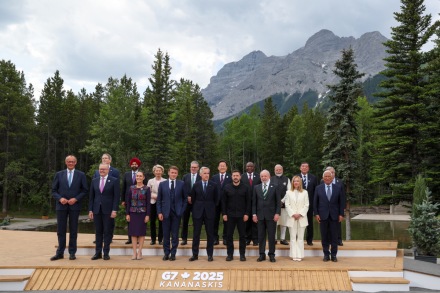By Amol Agrawal,
The G7 meeting in Canada last month made waves, mainly for the wrong reasons. US President Donald Trump did not just leave the meeting in the middle but also attacked Iran, pushing the world to the brink of another world war. The G7 was established 50 years ago, but things have not changed much since then.
The start of the 1970s brought multiple economic crises in the world economy—the breakdown of Bretton Woods, oil shock, and dual problems of high inflation and high unemployment. To address the crises, in 1973, then US treasury secretary George Schulz held an informal meeting with the finance ministers of the UK, France, and Germany. In mid-1973, Japan was added, making it G5.
In 1975, most of the G5 countries went through political turmoil and leadership changes. Given the crisis in geopolitics and geoeconomics, the French presidency organised the first formal meeting of the G5, with Italy as the sixth member, at Château de Rambouillet. G6 decided to meet every year under a rotational presidency, and added Canada as the seventh member to become G7. Over 50 years, G7 became a major platform for advanced economies to coordinate their economic policies. In 1981, the European Economic Community was made an informal member and was replaced by the European Union in 2009. Russia was made a member in 1998, but its membership was suspended after Russia’s annexation of Crimea in 2014.
Fast forward to now, the G7 meeting was held at Kananaskis, Canada. When we compare the declarations 50 years apart, we see both similarities and differences.
Let us start with the similarities first. The Rambouillet declaration stated that the member governments were “responsible of an open, democratic society, dedicated to individual liberty and social advancement”. The Kananaskis declaration voices similar sentiments of maintaining an open and democratic society. Both declarations echo the need to drive inclusive growth and sustained investment. Moreover, there were concerns over energy security in both 1975 and 2025.
In terms of differences, high inflation was a major concern in 1975 but there is no mention of inflation in the 2025 document. The 1975 declaration also mentioned the role monetary authorities needed to play to restore price and financial stability. In 2025, the monetary authorities have fared better in price stability. The credit goes to the adoption of an inflation target of 2% in most of these economies. Though the inflation is higher than targeted in most of the G7 economies, it is much lower than the double-digit inflation of 1975.
The 1975 declaration also discussed how developing countries had high trade deficits and were resorting to protectionism. It argued for a cooperative relationship and improved understanding between developed and developing countries. How the tables have turned in 2025! It is the developed countries, especially the US, that have high trade deficits and are resorting to protectionism. The economic fortunes of developed and developing countries have reversed. In 1980, the share of developed countries in the world GDP was 63%, which has declined to 40% in 2025. Within the same period, the share of developing economies has nearly reversed from 37% to 60%. There is a reason why G7 invites several developing countries to its meetings. We see similar trends in most macroeconomic indicators, with the developing world doing better than G7 and other advanced economies.
The other major difference in the 2025 declaration is the number of conflicts the world is facing currently and the threat of nuclear weapons—not that the 1970s were any more peaceful, with multiple wars being fought even back then. The 2025 declaration mentions the Russia-Ukraine war and highlights the US’s efforts to restore peace in the region. On the ongoing conflict in West Asia, it mentioned that Iran cannot have nuclear weapons and asserted Israel’s right to defend itself. Nuclear weapons find another mention as G7 is concerned with the Democratic People’s Republic of Korea’s (North Korea) nuclear weapons and ballistic missile programmes.
One major change is the mention of China, which has emerged as a big power challenging the supremacy of G7. It notes the country’s destabilising activities in the East and South China Seas and the need to maintain stable relations with it.
In all the discussion on conflicts, the G7 absolves itself from playing a key role in igniting them. They say peace but mean war. For a long time, these economies have not just spent on defence but also partnered with defence companies. The ongoing wars are being fought with jets and guns manufactured by companies from mainly the so-called G7 economies. The governments of these countries usually pitch for these companies to other countries.
In several ways, none of the warmongering is new. Much of human history has revolved around conflicts. Economists have, for a long time, argued that a military economy is the key to capitalism. After the two World Wars, one would have imagined we would settle for peace. Yet, countries have only spent more on military expansion and not on public welfare. We are seeing similar trends now. Humanity never learns that wars may magnify the profiles of leaders, but only multiply the misery for the people.
The author teaches at National Institute of Securities Markets.
